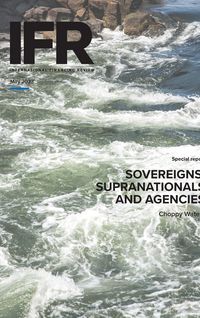![]()
Produced in association with the European Investment Bank
Uniform sustainable finance framework
Europe’s regulatory and supervisory framework for sustainable finance is rapidly evolving towards a single classification system for economic activities that contribute substantially to EU sustainability objectives. This should pave the way for a clearer description of the compatibility – or not – of the rest of the economy with those objectives. Ultimately, the objective is to fight greenwashing in finance and the economy to make sustainable investment more effective.
Green and more generally sustainability bonds with dedicated use of proceeds are core instruments of this clarification process, as bond markets have proven more dynamic than other financial segments (such as loans) and investors react quickly to new official investment guidelines.
Within the framework created by the EU Taxonomy Regulation of July 2020, the European Commission has proposed a regulation on European green bonds that aims to establish an EU Green Bond Standard (EUGBS). This proposal was debated by the EU co-legislators, who reached a provisional agreement at the end of February 2023. The regulation is now being finalised.
Extensive debate on non-financial disclosures
The EU Green Bond Standard stipulates that the use of proceeds must be aligned with the EU Taxonomy. An extensive debate on non-financial disclosures is underway, as verifiable, comparable evidence on the use of funds is becoming a requirement for labelling these bonds.
“Increasingly, investors are being requested to assess and report the sustainability of their investment portfolios as part of their EU Sustainable Finance Disclosure Regulation obligations. They are thus developing into catalysts of due diligence, relative assessment and promotion of sustainability in the whole economy,” said Aldo Romani, head of sustainable finance in the EIB’s finance directorate. The challenge here is that investors “may require information from issuers that do not yet have it”, he said.
Notably, such information is only partially available in the fields of “Do No Significant Harm” (DNSH) and “Minimum Safeguards” (MS) that are considered alongside an activity’s “Substantial Contribution”.
Several usability issues have been raised and different pieces of regulation are not perfectly matched. A report of the EU Platform on Sustainable
Finance, an expert group that provides recommendations to the European Commission, drew attention to these challenges at the end of 2022.
Voluntary versus mandatory approach
Growing demand for reliable and accountable information also comes with the burden of additional work. Not everybody in the market is happy with extra reporting obligations and the potential for increasingly proscriptive regulation.
In December ICMA – the guardian of the Green Bond Principles – expressed concerns that “making bond-level taxonomy disclosure mandatory could come with unintended consequences such as issuer deterrence and increased costs” and threaten Europe’s leading role in the development of sustainable finance.
The EU has taken stock of these views, agreed on the voluntary nature of the EUGBS, and included “a framework for disclosures … that are keen to show they are serious about their green claims but not yet able to adhere to the strict standards of the gold standard”. This approach highlights the enabling nature of the upcoming regulation, raising the question of how best to adapt to it. Progressive alignment with EU
Taxonomy and EUGBS are important features of the EIB’s approach and a relevant example to the market.
EIB as a test case
The EIB has taken a pragmatic approach in its frameworks for Climate Awareness Bonds (CAB) and Sustainability Awareness Bonds (SAB), aligning with the logic of the EU Taxonomy from an early stage. This has produced easy to understand tables that Romani said “give a clear and reliable picture of the criteria used for allocation of the bonds and their progress over time”.
In the latest edition of its CAB and SAB frameworks, the EIB also compared its environmental and social standards with the provisions of Articles 17 and 18 of the EU Taxonomy Regulation, which address DNSH and MS.
“EIB is also one of the few issuers to have supervised auditors looking at the reports and probably the only one reporting with reasonable assurance in the market, where the prevailing practice is limited assurance,” said Romani.
Establishing a checklist where core information can easily be accessed is critical to the development of sustainable finance. Without it the level of standardisation and comparability needed by the market to make efficient decisions is missing.
“With these frameworks, we have provided more ‘hierarchy’ to the discussion on sustainable finance regulation,” said Tomomitsu Maruta, sustainable finance associate. “Establishing an order of priorities enables greater standardisation of information.”
Pragmatic approach to gradual alignment
Romani said it is not necessary to have immediate compliance with a full set of criteria when “it is not yet possible”.
“Delays in conforming to the regulations can be explained; it is an incremental process,” said Romani.
What is more important is to set the condition that alignment with the logic of the taxonomy is put in place. “We need to create a constructive environment and for this we need a proper narrative,” said Romani. “It’s not just a question of policing people; it’s about creating the right conditions to incentivise them to produce the required information in a comparable way so that markets can monitor progress. This will encourage and steer improvements through efficient pricing of sustainable finance.”
If reporting around sustainable finance becomes too onerous and costly then the market will shun its use. But the EIB has a more nuanced attitude to the dilemma and contends that its frameworks show that its gradual alignment approach has already produced relevant results.
“We’re focused on communicating the relevance of this approach in pragmatic terms,” said Romani. “We don’t want it to be a mere internal exercise, we want to raise the level of dialogue with investors and regulators in a constructive dialectic process.”
Rather than stifling the use of sustainable finance, the iterative approach may have wider benefits. “If the EU is able to implement its framework in a way that it is easy to use and easily verified by auditors, then this will be a very powerful tool for the efficiency of its internal market in the interest of the European Union,” said Maruta.
“It will also give Europe the value of a reference and drive other markets along,” added Romani.

Aldo Romani
Head of sustainable finance in the EIB’s finance directorate

Tomomitsu Maruta
Sustainable finance associate
Produced in association with the EIB
To see the digital version of this report, please click here
To purchase printed copies or a PDF of this report, please email leonie.welss@lseg.com
Noine


